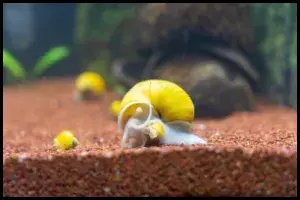
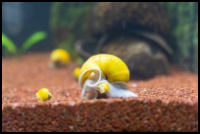
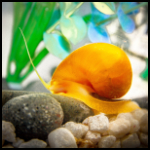
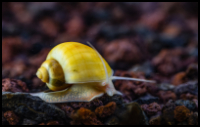
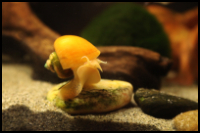
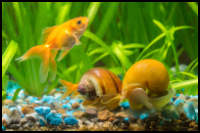
Quick Care Details (Table)
| Livestock Characteristics | Value |
|---|---|
| Care Level | Easy |
| Temperament | Peaceful |
| Diet | Omnivore |
| Maximum Size | 1.5 Inches |
| Minimum Tank Size | 5 Gallons |
| Plant Safe | Yes |
| Temperature Range | 68-84F |
| PH Range | 7.5-8.5 |
| KH Range | 12-18 |
Species Specific Categories
Helpful Video
Care Details
Aquascape: Gold Mystery Snails can thrive in a variety of aquascapes, but they prefer freshwater setups with live or artificial plants, driftwood, and rocks. Their algae-eating behavior makes them a useful addition to planted aquariums.
Substrate: They don't have specific substrate requirements, but a soft, sandy substrate is ideal for them as it won't damage their delicate tentacles.
Disease Prevention: Keep water conditions stable, maintain good filtration, and avoid overfeeding to prevent diseases. Quarantine new additions to the tank to prevent introducing potential diseases.
Filtration: Gold Mystery Snails benefit from well-filtered tanks with good water circulation, which helps maintain water quality and oxygen levels.
Lighting: They don't have specific lighting needs, but moderate lighting is ideal to support plant growth in the aquarium.
Water Flow: Gold Mystery Snails are adaptable to various water flow conditions, but avoid strong currents to prevent them from getting knocked over.
Hardiness: These snails are relatively hardy, making them suitable for beginners. They can tolerate a range of water conditions.
Acclimation: Gradual acclimation to your tank's water conditions is crucial to reduce stress on the snails when introducing them to their new environment.
Expected Lifespan: Gold Mystery Snails typically live for 1 to 2 years in captivity, although some individuals can live longer.
Special Requirements: They have no specific special requirements, but ensure stable water parameters, and be cautious with copper-based medications, which can be harmful to them.
Temperament and Behavior
Behavior: Gold Mystery Snails are peaceful and easy-going. They spend their time gliding around the aquarium, foraging for food and algae. These snails are known for their interesting and sometimes comical behavior as they move across the glass, plants, and substrate.
Breeding: Gold Mystery Snails are known to lay their eggs above the waterline in a clutch. The clutch resembles a small pink or tan blob and can be seen adhering to the tank glass or other surfaces. If you want to breed them, you'll need to ensure high humidity and protect the clutch from potential predators.
Aggression: These snails are not aggressive at all. They are docile creatures that won't harm other tank inhabitants.
Tankmates Compatibility: Gold Mystery Snails are compatible with most peaceful aquarium fish. They are an excellent choice for community tanks and do well with species like guppies, tetras, and peaceful cichlids. However, avoid keeping them with aggressive or larger species that may harass or eat the snails.
Activity Level: These snails are generally active and can be seen crawling and grazing throughout the day. They become particularly active during feeding times.
Schooling or Shoaling Behavior: Gold Mystery Snails are not shoaling or schooling creatures. They are solitary and don't require companions of their own kind.
Plant Compatibility: They are plant-safe and can be kept in planted tanks. They primarily feed on algae and detritus, and while they may nibble on soft, decaying plant matter, they don't harm healthy plants.
Diet and Nutrition
Dry Foods: Gold Mystery Snails are primarily herbivores and feed on a variety of dry foods. They readily consume sinking algae wafers, spirulina pellets, and high-quality vegetable-based flake foods. These commercial dry foods are designed to meet their nutritional needs.
Frozen Foods: While Gold Mystery Snails primarily feed on plant matter, they may occasionally consume small amounts of frozen foods like daphnia, brine shrimp, or bloodworms. These can be offered as occasional treats to provide some variety in their diet.
Live Foods: Gold Mystery Snails are not known for actively hunting live foods. They are detritivores, meaning they feed on decaying plant matter, algae, and detritus in the aquarium. Therefore, live foods are not a significant part of their diet.
Vegetables: Fresh vegetables are a vital component of their diet. They enjoy vegetables like blanched zucchini, cucumber, spinach, and lettuce. These should be weighted down in the tank, and any uneaten portions should be removed to prevent water quality issues.
Algae: Gold Mystery Snails are excellent algae eaters. They graze on the algae that naturally grow in the aquarium. Their appetite for algae makes them valuable for maintaining a clean tank.
Feeding Schedule: Gold Mystery Snails are not picky eaters and will constantly graze for food throughout the day. You can feed them small amounts of food once a day, ensuring that they have a varied diet that includes both plant-based and protein-based foods.
Supplemental Foods: Occasionally, you can supplement their diet with calcium-rich foods like cuttlebone or crushed coral to promote healthy shell growth. These snails need calcium to maintain the integrity of their shells.
Tank Parameters
Tank Size: Gold Mystery Snails can be kept in a variety of tank sizes, but a 10-gallon aquarium or larger is recommended to provide them with enough space. If you plan to keep multiple snails, consider a larger tank to accommodate their needs comfortably.
Tank Length and Measurements: In a 10-gallon tank, the typical measurements might be 20 inches in length, 10 inches in width, and 12 inches in height. However, you can choose tanks with different dimensions as long as they provide enough floor space for your snails to forage and explore.
Water Temperature: Gold Mystery Snails thrive in tropical freshwater environments with a water temperature range of 68-82°F (20-28°C). Maintaining a stable temperature within this range is crucial for their well-being.
pH (Acidity/Alkalinity): These snails are adaptable and can tolerate a wide pH range, typically between 7.0 and 8.0. Aim for a pH level around 7.5 for ideal conditions.
KH (Carbonate Hardness): The carbonate hardness should be in the range of 5-15 dKH (carbonate hardness). This range helps maintain the stability of the water and prevents pH fluctuations.
GH (General Hardness): The general hardness should be around 6-12 dGH (general hardness). Adequate hardness ensures healthy shell growth and overall well-being for Gold Mystery Snails.
Hardiness: Gold Mystery Snails are considered quite hardy and can adapt to a range of water conditions. This makes them suitable for beginners and experienced aquarists alike.
Nitrate (NO3) levels: Gold Mystery Snails are sensitive to high nitrate levels. It's essential to maintain nitrate levels below 40 ppm (parts per million). Regular water changes and efficient filtration can help keep nitrate levels in check.
History, Popularity, History and Species Variety Details
The History, Popularity and Natural Habitat
History: These snails are native to South America, particularly in countries like Bolivia, Brazil, and Peru. Historically, they have been an essential part of the diet for indigenous people in these regions. In recent years, they have gained popularity as captivating aquarium pets, appreciated for their striking golden or yellowish shells.
Popularity: Gold Mystery Snails have become increasingly popular in the aquarium hobby due to their unique appearance, peaceful nature, and their valuable role in maintaining a clean and balanced aquarium environment. Their distinctive gold or yellow shells and algae-eating habits make them a favorite choice among aquarists looking to add both beauty and functionality to their tanks.
Natural Habitat: In the wild, Gold Mystery Snails inhabit various freshwater environments, including ponds, rivers, and swamps. They are known for their ability to breathe both in and out of the water, thanks to a specialized lung. These snails often dwell in slow-moving or stagnant waters and are well-adapted to fluctuating water conditions.
Understanding the historical context and natural habitat of Gold Mystery Snails can help aquarists recreate suitable conditions in their tanks. These snails have thrived in diverse environments, making them adaptable and relatively easy to care for in home aquariums.
Back to topVariations of the Golden Mystery Snail
- Striped Gold Mystery Snail: Some Gold Mystery Snails have distinctive stripes or bands on their shells. These stripes can vary in color and pattern, adding a unique aesthetic to the snail.
- Albino Gold Mystery Snail: Albino variations of Gold Mystery Snails are characterized by their lack of pigmentation, resulting in a pale, nearly translucent appearance.
- Black Mystery Snail: While not a variation of the Gold Mystery Snail, the Black Mystery Snail (Pomacea diffusa) is a closely related species known for its dark, almost black shells. They are sometimes kept alongside Gold Mystery Snails in aquariums.
Similar snails that you might also want to try
- Mystery Snails (Pomacea diffusa): Mystery snails, sometimes called Pomacea diffusa or "spike-topped applesnails," are available in various colors. They are peaceful and will graze on algae and detritus, making them good tank cleaners.
- Japanese Trapdoor Snails (Viviparus malleatus): These snails are known for their distinctive round operculum (trapdoor) that they use to seal themselves in their shells. They are algae-eating snails and are usually peaceful tank inhabitants.
- Nerite Snails (Neritina sp.): Nerite snails are well-known for their attractive patterns and relatively small size. They are excellent algae eaters and are generally peaceful tank inhabitants. Common species include Zebra Nerite, Tiger Nerite, and Olive Nerite.
- Apple Snails (Pomacea canaliculata): These are a larger snail species and are available in various colors, including gold, blue, and ivory. While they can be good tank cleaners, they are known for their ability to breed rapidly, so consider this if you add them to your tank.
Frequently Asked Questions
Can I keep Gold Mystery Snails in a planted tank?
Yes, they're compatible with live plants. They may occasionally munch on decaying plant matter but generally won't harm healthy plants.
How can I tell if a Gold Mystery Snail is healthy?
Look for a snail with a smooth, intact shell and active behavior. Lethargy, holes in the shell, or a damaged foot may indicate health issues.
Are there any water quality parameters to consider when keeping these snails?
Maintain good water quality with parameters such as neutral pH, low ammonia and nitrite levels, and stable water conditions. Avoid copper-based medications, which can harm them.
What's the average lifespan of Gold Mystery Snails?
Gold Mystery Snails typically live for about 1-2 years, although some can live longer with proper care.
Do Gold Mystery Snails reproduce quickly?
They are not known to overpopulate aquariums as some other snail species do, but they can still lay eggs above the waterline. Remove these egg clutches if you wish to control their population.
How can I acclimate Gold Mystery Snails to my aquarium?
Floating the bag in your tank to allow the water temperature to equalize for about 15-20 minutes is a common acclimation method.
Can Gold Mystery Snails live with other fish and invertebrates?
Generally, they are peaceful and compatible with most community fish and non-aggressive invertebrates. However, avoid housing them with species known to harass or prey on snails.
How often should I feed them?
Feed them once a day or every other day, adjusting the quantity to ensure they consume the food within a few hours.
What should I feed my Gold Mystery Snails?
They're primarily herbivores, so a diet of algae wafers, blanched vegetables (like zucchini or spinach), and high-quality sinking pellets or flakes is ideal.
Do Gold Mystery Snails require a specific water temperature?
These snails thrive in a temperature range of 68-84°F (20-29°C), making them adaptable to a variety of aquarium setups.
Are Gold Mystery Snails good for algae control?
Yes, they're effective algae eaters and can help keep your tank clean by grazing on algae and detritus.
What are Gold Mystery Snails, and how big do they grow?
Gold Mystery Snails are a type of freshwater aquarium snail known for their striking golden shells. They typically grow to be around 2 inches (5 cm) in diameter.

